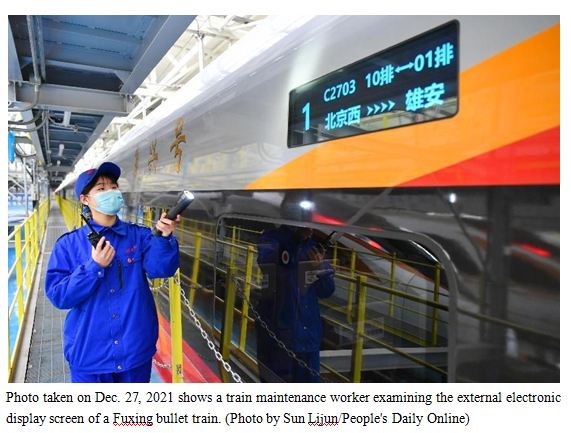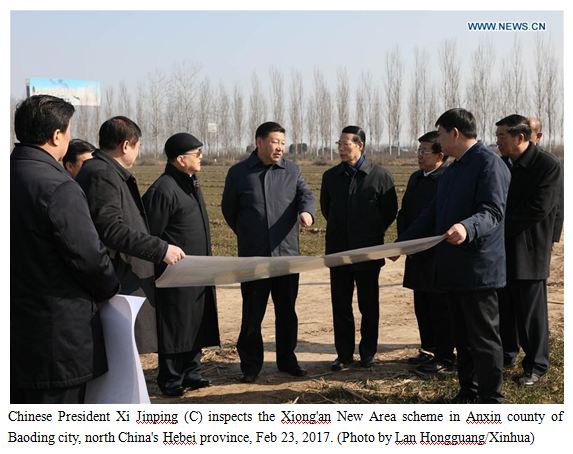By Bu Le, People’s Daily
Boasting a civilization spanning more than 5,000 years, China is home to many thousand-year-old cities. According to incomplete statistics, 30 cities in China were built over 2,000 years ago, and 142 cities have been officially designated as national historical and cultural cities.
The history of cities represents the evolution of human civilization, a truth that holds universally without exception. Then, in the 21st century today, can a country design and build a “city of future” with lasting importance for the millennium to come?
Impossible as it sounds, the miracle is happening in Xiong’an New Area, north China’s Hebei province.
Six years ago, Chinese President Xi Jinping announced the plan to set up Xiong’an New Area. “We will relieve Beijing of functions nonessential to its role as the capital and use this effort to drive the coordinated development of the Beijing-Tianjin-Hebei region; and we will develop forward-looking plans and adopt high standards for building the Xiong’an New Area,” he said.
Xiong’an New Area is a historical heritage for future generations. Xi call for “global vision, international standards, distinctive Chinese features, and future-oriented goals” in the planning and construction of Xiong’an New Area has served as an important guideline for the development of the area.
Xiong’an has caught global attention since its establishment.
Singaporean newspaper Lianhe Zaobao pointed out that Xiong’an New Area will shoulder the strategic mission of searching for a path to the great transformation of the Chinese nation.
British daily business newspaper Financial Times said that Xiong’an New Area boosts strong and clear anticipation of growth in northern China.
Relevant articles published on the website of the Associated Press noticed that Xiong’an New Area is established to alleviate Beijing’s non-capital functions and promote the coordinated development of Beijing-Tianjin-Hebei, and bridge the economic disparity between the capital and the industrial and rural areas surrounding it.
Xiong’an New Area may provide an alternative development model and is expected to become a high-tech hub and a laboratory for intelligent city planning, according to an article published on the website of The Diplomat magazine based in Japan.
An article on the website of the British weekly newspaper The Economist quoted an official statement by China that the development of Xiong’an New Area is a “strategy crucial for the next millennium.” However, it said that it would be unwise to bet all on the rise of Xiong’an, because “over the years China has tried to build numerous new cities, several of which have been costly failures.”
It’s assumed that it must take a long time for Xiong’an New Area to finally take shape, since its development is considered a national project of millennial significance. This is probably why discussions regarding Xiong’an cooled off gradually after it became a hot topic worldwide for a period.
For more than two years after China officially announced its plan to establish, nothing significant was built in the area except for some basic projects and temporary structures designed to ensure necessary operations.
However, a grand blueprint was being formed step by step.
More than 1,000 experts and over 200 teams from home and abroad, together with more than 2,500 professional and technical personnel, have participated in the formulation of the master plan for Xiong’an New Area.
To the surprise of the world, the “city of future” has experienced tremendous changes within a mere six years. It has been transformed from ground zero to an emerging modern city with neatly aligned new buildings, flat and wide streets, and ubiquitous greenery.
On May 10, 2023, Xi made an inspection tour of Xiong’an, which was his third visit to the new area, bringing the new area under the spotlight once again. From the media’s focus on the inspection tour, major progress has been achieved in the development of Xiong’an.
The country has basically completed the top-level construction and development of Xiong’an, secured major progress in infrastructure construction, achieved initial results in relieving the non-capital functions of Beijing, improved the ecological environment management and protection of the Baiyangdian Lake in the new area, witnessed positive progress in deepening reform and opening up, gradually improved the conditions for the gathering of industrial and innovation elements, and promoted the relocation and resettlement work in an orderly manner.
The miraculous transformation of Xiong’an has aroused discussions, with many saying they have never before seen a plan for a city be formulated this way, which can take over Beijing’s non-capital functions and pays so much attention to the inheritance of fine traditional culture.
They are also surprised by the integrated construction and planning that cover projects above and below ground as well as on online platforms, and such great efforts to improve the ecological environment of the Baiyangdian Lake.
These remarks bear testimony to the historical foresight of the Chinese leadership.
Over the past six years, new changes have taken place in Xiong’an day by day, and major progress has been achieved in the construction of the new area every year. A high-level modern city is sprouting up.
The miracle that is unfolding in Xiong’an has demonstrated that effective city design of “millennial significance” requires not only a well-established civilization, but historical foresight and remarkable wisdom of a country’s leadership. Furthermore, the plan will only work when the government of the country has the resolve for continuous implementation.















